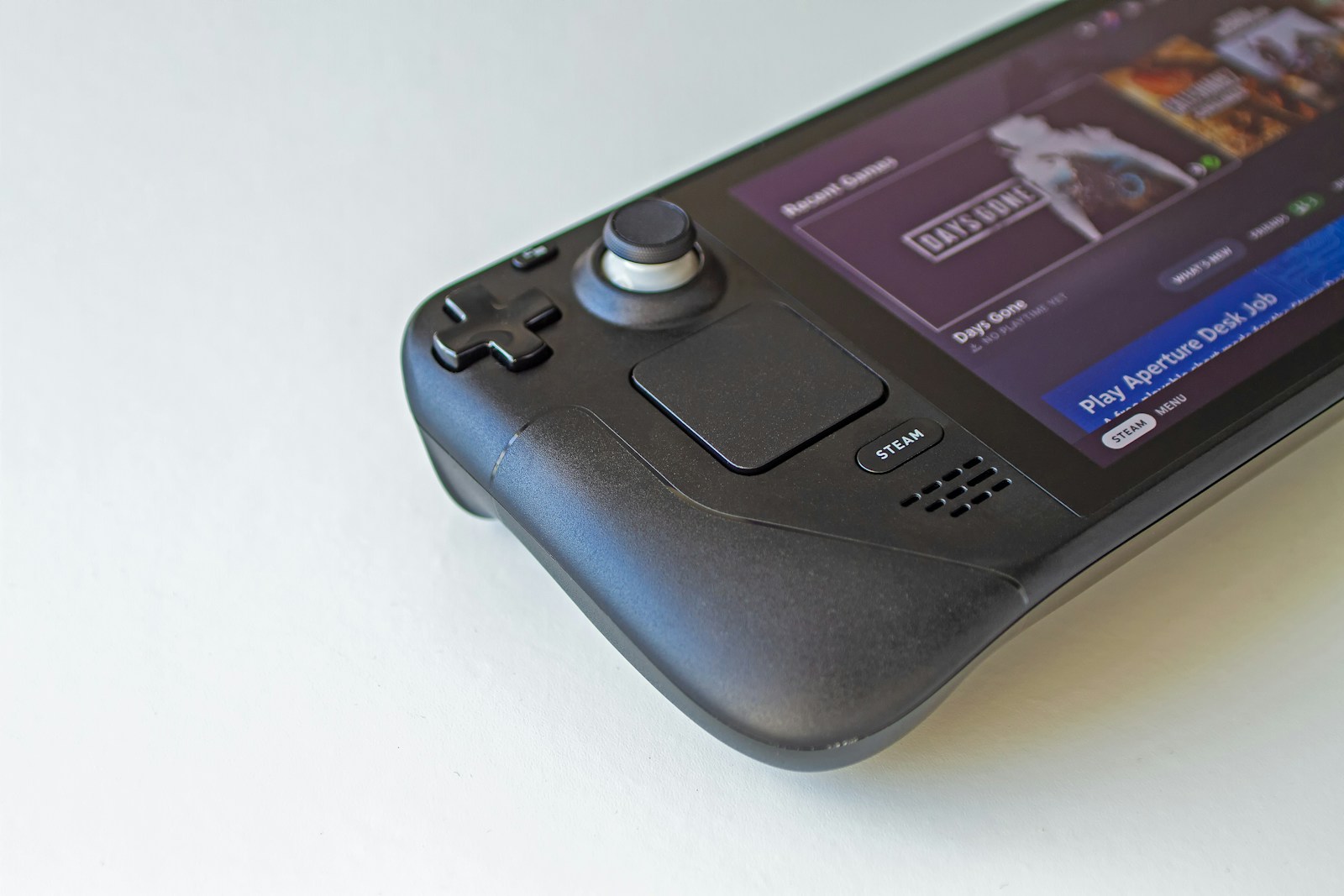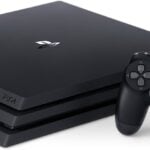Handheld gaming has undergone a revolution over the past few years, transforming from a niche category into a full-fledged gaming sector that rivals traditional consoles. With advances in chip technology, battery efficiency, and display quality, today’s handheld gaming consoles offer high-performance experiences previously limited to gaming PCs and home consoles.
In 2025, major manufacturers have doubled down on premium handheld gaming devices, introducing bigger screens, powerful processors, and improved battery technology to meet the demands of modern gaming. Valve’s Steam Deck OLED, Asus’s ROG Ally X, Ayaneo’s Ayaneo 3, Lenovo’s Legion Go S, and GPD Win Max 2 2025 represent the pinnacle of portable gaming in 2025, each with unique strengths that cater to different types of gamers.
Whether you’re looking for a balance between affordability and performance, a powerhouse machine that can handle AAA titles at high settings, or a hybrid gaming-laptop device, 2025 has something for everyone. Let’s dive into the top contenders and find out which premium handheld gaming console is the best.
Best Premium Handheld Gaming Consoles of 2025
Below is a ranking and breakdown of the top 5 handheld consoles for 2025 and how they compare:
| Rank | Handheld Console | Key Features | Price Range | Strengths | Weaknesses |
|---|---|---|---|---|---|
| 1 | Steam Deck OLED | Best balance of price, performance, and usability; large game library; improved battery life | Starts at $545 | Affordable; excellent software support; vast Steam library | Not all AAA titles run at max settings; battery life could be better |
| 2 | Asus ROG Ally X | Powerful AMD Ryzen Z1 Extreme; 120Hz touchscreen; excellent performance for AAA titles | Around $799 | Powerful hardware; high refresh rate screen; extended battery life | Windows OS is less intuitive than SteamOS; high price |
| 3 | Ayaneo 3 | High-resolution display; Ryzen 7 7840U processor; up to 4TB storage; premium build quality | $799 – $2,099 | Best display quality; high-end components; premium design | Expensive; requires technical knowledge to optimize |
| 4 | Lenovo Legion Go S | 8-inch screen; detachable controllers; Windows-based; versatile gaming experience | $729.99 | Large display; detachable controllers; versatile gameplay modes | Heavier and bulkier than competitors; battery life concerns |
| 5 | GPD Win Max 2 2025 | 10.1-inch 2.5K display; AMD Ryzen 7 8840U; up to 64GB RAM; hybrid laptop-handheld experience | Starts at $1,200 | Largest screen; doubles as a workstation; high-end specifications | Expensive; not as comfortable for handheld-only use |
1) Steam Deck OLED – The Best All-Around Handheld Gaming Console
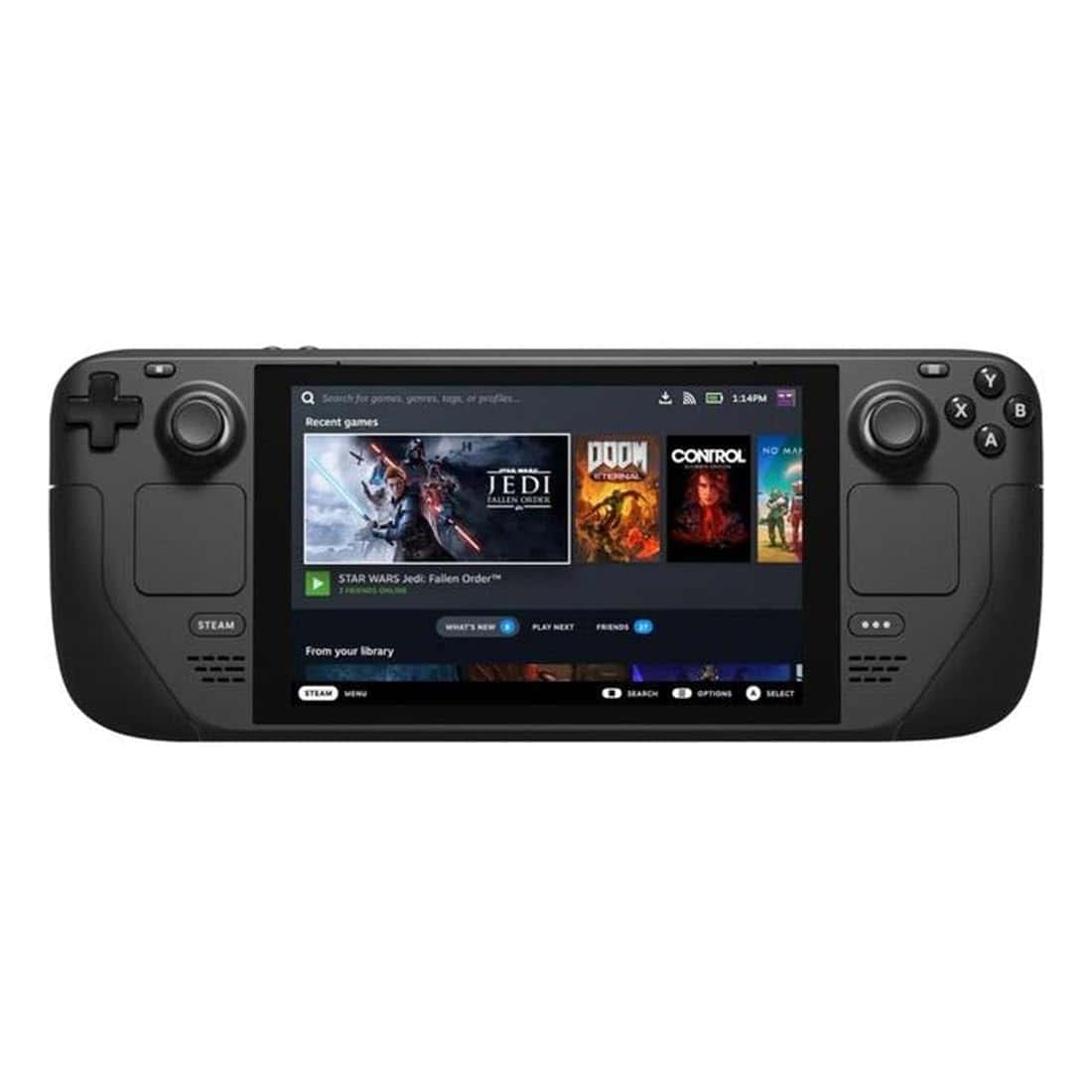
Since its launch, the Steam Deck has dominated the handheld PC market, capturing over half of total sales in the segment. With the release of the Steam Deck OLED, Valve has fine-tuned an already fantastic product, bringing improvements in display quality, battery life, and thermal efficiency.
The OLED model features a 7.4-inch HDR display, providing deeper blacks, brighter highlights, and more vibrant colors, making games look stunning in portable mode. Unlike many competitors that rely on Windows, the Steam Deck runs on SteamOS, a Linux-based operating system optimized for gaming, allowing for a seamless, console-like experience.
With Valve’s regular Steam Deck verification system, new and existing games are constantly optimized for the platform. As of 2025, over 12,000 games are verified or playable on Steam Deck, making it one of the most versatile gaming handhelds in terms of library access.
Why It Stands Out:
- Best overall balance of performance, price, and usability.
- Highly optimized SteamOS provides a smoother experience than Windows-based handhelds.
- Industry-leading game compatibility with thousands of Steam games verified.
- Improved battery life over the LCD version.
- Affordable compared to other high-end models.
2) Asus ROG Ally X – The Performance Powerhouse
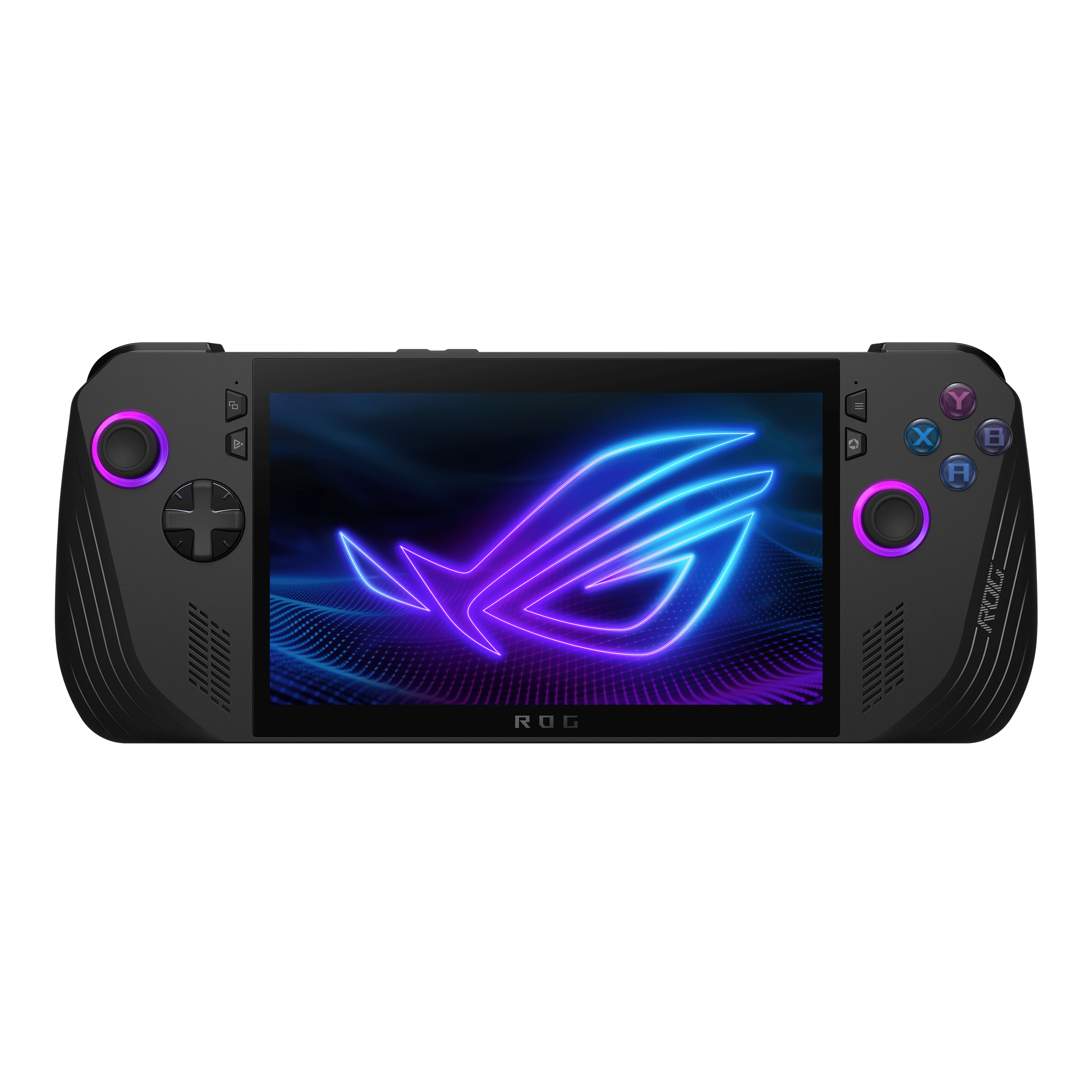
For gamers seeking raw power, the Asus ROG Ally X is one of the most powerful handheld gaming devices on the market. With an AMD Ryzen Z1 Extreme processor and an RDNA 3 GPU, it delivers desktop-like performance, making it ideal for AAA gaming.
Unlike the Steam Deck, the ROG Ally X runs on Windows 11, providing compatibility with Steam, Epic Games, Xbox Game Pass, and even cloud gaming services like NVIDIA GeForce NOW. This makes it one of the most versatile handhelds available.
The 7-inch 120Hz touchscreen offers smooth visuals, but its reliance on Windows is both a blessing and a curse. While it allows access to a vast range of PC games, Windows isn’t optimized for handheld use, making navigation slightly cumbersome compared to SteamOS.
Key Highlights:
- 120Hz touchscreen for smoother gameplay.
- Top-tier processing power for high-end gaming.
- Supports multiple gaming platforms beyond Steam.
- Better battery life than its predecessor.
Potential Downsides:
- More expensive than the Steam Deck OLED.
- Windows interface can be clunky on a handheld.
3) Ayaneo 3 – The Premium Enthusiast’s Choice
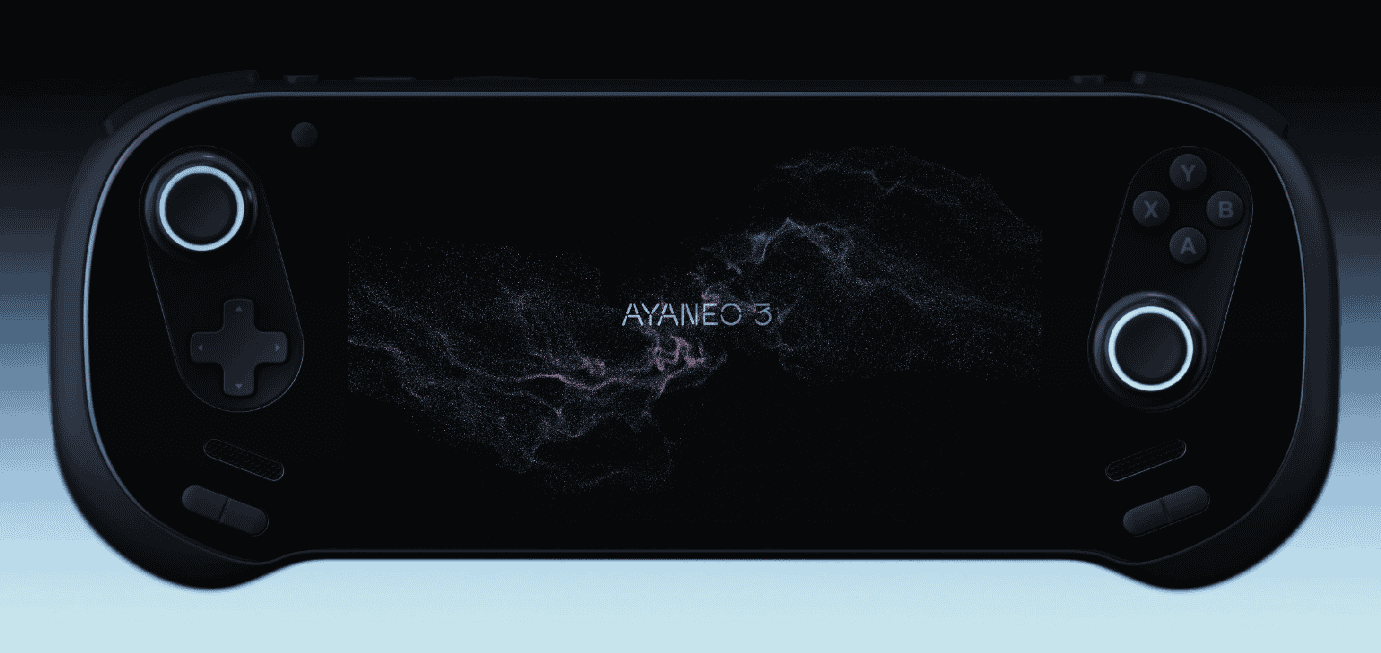
For those who want the absolute best in display quality and hardware, the Ayaneo 3 is in a class of its own. This boutique handheld PC features a high-resolution display, up to 4TB of SSD storage, and a premium build that feels luxurious compared to mainstream models.
Powered by an AMD Ryzen 7 7840U processor, the Ayaneo 3 outperforms most other handhelds, especially in games that require high-end graphics. Its biggest strengths lie in its beautiful high-resolution screen and top-tier specifications, making it a dream machine for serious gamers.
However, it comes at a cost—literally. The Ayaneo 3 starts at $799 and can go up to $2,099, making it one of the most expensive handhelds available. Additionally, it runs on Windows, meaning users have to deal with less intuitive UI compared to the Steam Deck.
Why It’s Special:
- Highest display quality among all handhelds.
- More storage options (up to 4TB) than competitors.
- Powerful processor capable of high-end gaming.
Drawbacks:
- Significantly more expensive than other handhelds.
- Battery life isn’t as strong due to high power draw.
4) Lenovo Legion Go S – The Largest Screen & Detachable Controllers

The Lenovo Legion Go S brings some unique features to the table, particularly its 8-inch display—the largest among major handhelds in 2025. This makes it an ideal choice for gamers who prioritize screen real estate for an immersive experience.
Its detachable controllers allow for flexibility in playstyles, similar to the Nintendo Switch. However, it doesn’t quite match the performance of the ROG Ally X or Ayaneo 3, making it more of a hybrid option rather than a powerhouse gaming device.
Strengths:
- Largest display among handhelds (8 inches).
- Detachable controllers for flexible playstyles.
- Runs Windows, allowing for a variety of gaming platforms.
Weaknesses:
- Performance lags behind other high-end competitors.
- Bulkier design compared to the Steam Deck or ROG Ally X.
- Battery life concerns when playing demanding titles.
5) GPD Win Max 2 2025 – The Hybrid Laptop-Handheld
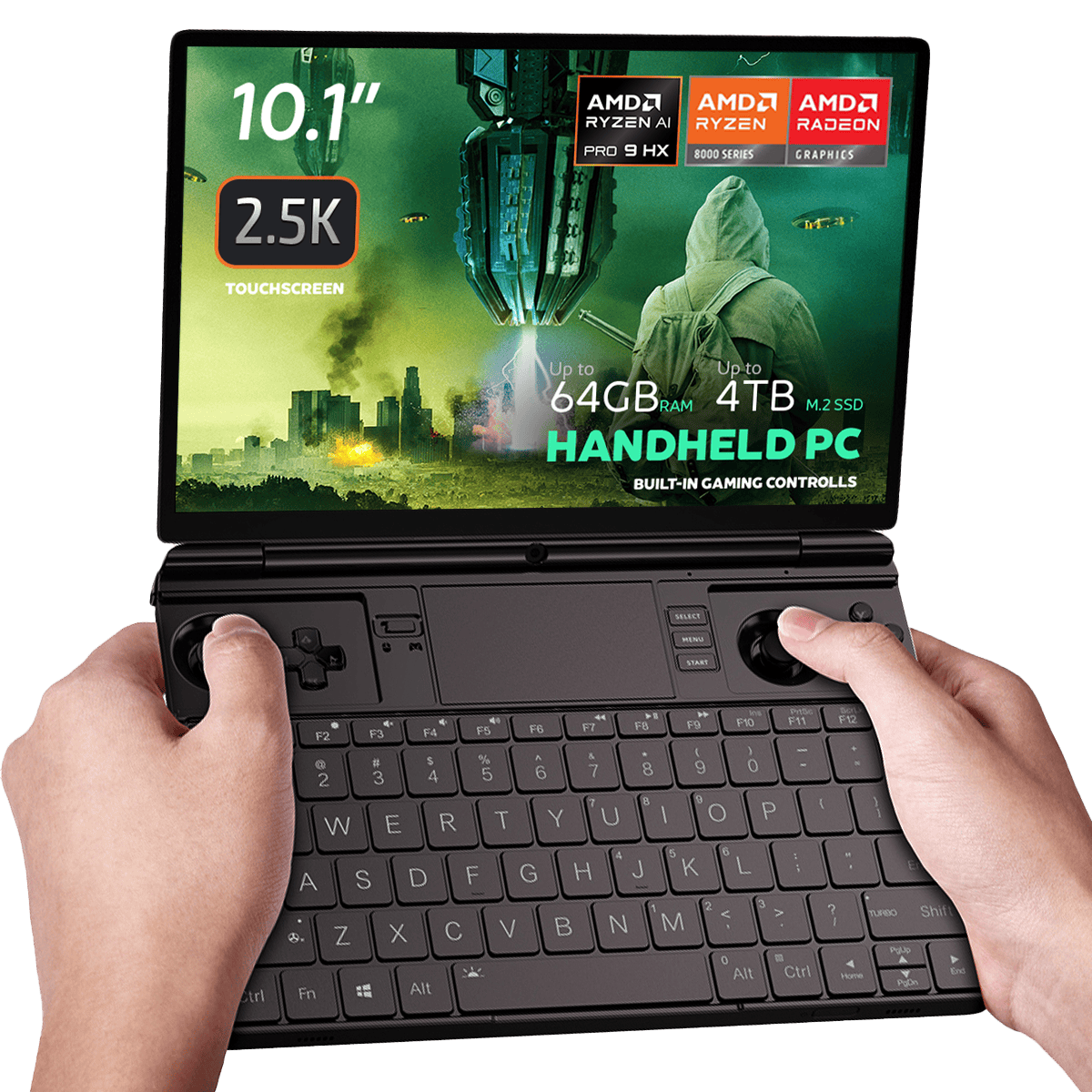
For those who want a handheld gaming PC that can double as a productivity device, the GPD Win Max 2 2025 is a game-changer. Featuring a 10.1-inch 2.5K display, a full keyboard, and high-end specs, this device is more of a gaming laptop in a handheld form factor.
While it excels in productivity and gaming, its size and weight make it less comfortable for traditional handheld gaming. Additionally, its starting price of $1,200 makes it an expensive niche option.
Key Features:
- Largest screen of all handhelds (10.1 inches).
- Doubles as a full productivity laptop.
- Powerful AMD Ryzen 7 8840U processor.
Cons:
- Not as ergonomic for handheld gaming.
- Expensive, starting at $1,200.
Final Verdict
Each of these handhelds offers something unique. If you want the best all-around experience, the Steam Deck OLED is the clear winner. If you prefer high-end performance, the ROG Ally X or Ayaneo 3 are excellent choices. The Legion Go S and GPD Win Max 2 cater to specific needs, whether you want a bigger screen or a productivity powerhouse.
Ultimately, the best premium handheld gaming console depends on your gaming preferences and budget.
Video Reviews and More Details For The Consoles
1) Steam Deck (OLED)
The Steam Deck continues to dominate the handheld gaming market in 2025, maintaining its position as the best handheld gaming PC ever made. Since its debut in 2022, Valve’s portable device has shipped over 3.7 million units, capturing more than half of the handheld PC gaming market.
Both the original LCD model and the newer OLED version offer PC gaming on the go with impressive capabilities. The OLED model stands out with enhanced display quality, providing more vibrant colors and deeper blacks that make games look stunning in portable format.
One of the Steam Deck’s biggest strengths is its user interface. The device provides an intuitive experience that makes accessing and playing PC games simple and straightforward. This accessibility has helped it appeal to both hardcore gamers and casual players alike.
Performance remains reliable across most modern titles. While not every AAA game runs at maximum settings, the Steam Deck handles an impressive library of games at playable framerates. Players can adjust graphics settings to find the right balance between visual quality and performance.
Battery life has seen improvements, especially with the OLED model. The LCD version offers fantastic battery life for its price point, while the OLED pushes this even further, allowing for longer gaming sessions away from power outlets.
Pricing remains competitive in the growing handheld market. The base model provides an affordable entry point, while higher storage options and the OLED variant offer premium experiences for those willing to spend more. This tiered approach has helped Steam Deck reach a wide audience.
Game compatibility continues to expand. Valve regularly updates its verification system, marking more titles as “Verified” or “Playable” on Steam Deck. This growing library includes everything from indie gems to major releases.
The Steam Deck offers the best balance of price, performance and usability in today’s handheld gaming market. Its combination of PC power, portability, and access to Steam’s vast library makes it a compelling choice for gamers seeking flexibility without compromising too much on performance.
2) Asus ROG Ally X
The Asus ROG Ally X cements its place as a powerhouse in the handheld gaming market in 2025, offering one of the most premium experiences available. Asus has refined its portable gaming device with improved ergonomics, a larger battery, and better thermal performance, making it a strong contender against the Steam Deck OLED.
With a sharp 7-inch 120Hz touchscreen and a powerful AMD Ryzen Z1 Extreme processor, the ROG Ally X delivers impressive gaming performance, rivaling many mid-range gaming laptops. It supports a wide range of PC games thanks to its Windows 11 operating system, allowing players to run Steam, Epic Games, Xbox Game Pass, and other platforms without restriction.
One of its standout features is its ability to play modern AAA games at higher settings compared to other handhelds. While some titles may require adjustments to achieve optimal performance, the ROG Ally X provides a more fluid experience with its high refresh rate display and RDNA 3 graphics.
Battery life has been significantly improved over the original model, boasting an 80Wh battery that extends gameplay sessions far beyond its predecessor. This makes it one of the best handhelds for gamers who want long-lasting performance on the go.
Pricing is on the higher end, reflecting its premium build and high-end specs. At $799, it’s more expensive than the Steam Deck OLED but offers a more powerful alternative for gamers who demand the best performance possible from a handheld PC.
Game compatibility is excellent due to its Windows-based platform, but the downside is that navigating Windows can sometimes feel cumbersome on a handheld device. Asus has worked to improve the user experience with software optimizations, but the interface still lacks the seamless ease of use found on the Steam Deck.
For gamers who prioritize performance, display quality, and battery life, the Asus ROG Ally X is one of the most powerful handheld gaming PCs on the market today. It’s an excellent choice for those who want a high-end alternative to Valve’s Steam Deck with a focus on raw power and versatility.
3) Ayaneo 3
The Ayaneo 3 sets itself apart in 2025 as one of the most high-end handheld gaming consoles available, pushing the boundaries of portable gaming performance. Known for its sleek design, powerful internals, and premium build quality, Ayaneo continues to target serious enthusiasts willing to invest in a top-tier experience.
Equipped with an AMD Ryzen 7 7840U processor, LPDDR5X RAM, and up to 4TB of SSD storage, the Ayaneo 3 is one of the most powerful handhelds in existence. Unlike other mainstream devices, it caters to gamers looking for a boutique, high-end alternative with cutting-edge specifications.
One of the defining features of the Ayaneo 3 is its stunning high-resolution display, which delivers sharper visuals and more vibrant colors than many of its competitors. This makes it an excellent choice for those who prioritize display quality alongside raw performance.
Performance-wise, the Ayaneo 3 can handle even the most demanding AAA titles at high settings, often outperforming the Steam Deck and ROG Ally in terms of raw power. However, this comes at the cost of efficiency—battery life is shorter than its competitors, and power draw can be quite high.
Unlike the Steam Deck and ROG Ally, which have large companies supporting their software, the Ayaneo 3 runs Windows but lacks a polished custom UI. This means users must navigate Windows manually, which can be cumbersome for casual players but offers deep customization for power users.
Pricing starts at around $799 but can exceed $2,000 for the highest-end configurations. This makes the Ayaneo 3 one of the most expensive handheld gaming devices, catering primarily to enthusiasts who demand the best and are willing to pay for it.
For those who want a truly premium, boutique gaming experience, the Ayaneo 3 is unmatched in performance and build quality. However, its high price and shorter battery life make it a niche option for serious PC gamers who are comfortable fine-tuning their setup for optimal performance.
4) Lenovo Legion Go S
The Lenovo Legion Go S is Lenovo’s answer to the growing demand for powerful handheld gaming PCs in 2025. Building upon the foundation of its predecessor, the Legion Go S features an 8-inch display, detachable controllers, and a Windows-based platform for broad game compatibility.
One of the most noticeable upgrades in the Legion Go S is its screen. At 8 inches, it is larger than most competitors, offering a more immersive gaming experience with a variable refresh rate that adapts to different types of games. This makes it a strong option for those who prioritize screen real estate in handheld gaming.
The device is powered by an AMD Ryzen 7 8840U processor, similar to what is found in other premium handhelds. While performance is strong, it doesn’t quite reach the level of the Ayaneo 3 or ROG Ally X, meaning some demanding games may require graphical adjustments for smooth performance.
Battery life is decent but not outstanding. While Lenovo has improved efficiency compared to the previous model, it still lags behind the Steam Deck OLED and ROG Ally X when it comes to longevity during extended gaming sessions.
One of the unique features of the Legion Go S is its detachable controllers, similar to the Nintendo Switch. This allows for a more versatile gaming experience, including tabletop mode and different grip styles. However, the controllers can feel slightly bulkier than those found on other handhelds.
At $729.99, the Legion Go S is priced competitively, but its performance doesn’t quite match up to the Steam Deck OLED or the ROG Ally X. Additionally, the Windows operating system can feel clunky on a handheld, making navigation less intuitive than Valve’s Steam OS.
Overall, the Lenovo Legion Go S is a solid choice for gamers who want a larger screen, detachable controllers, and a unique form factor. However, its performance and software experience may not be as polished as some of its competitors, making it a better fit for those who prioritize versatility over sheer power.
5) GPD Win Max 2 2025
The GPD Win Max 2 2025 blurs the line between a handheld gaming device and an ultra-portable laptop, offering a unique hybrid experience for gamers who want both portability and workstation capabilities.
Featuring a 10.1-inch 2.5K LTPS display, this device boasts the largest screen of any handheld gaming PC on the market. This makes it ideal for those who prefer a more laptop-like experience without sacrificing portability.
Under the hood, the Win Max 2 2025 is powered by an AMD Ryzen 7 8840U processor, up to 64GB of RAM, and up to 4TB of SSD storage. This makes it one of the most powerful handhelds available, capable of running high-end PC games and even productivity applications with ease.
Unlike other handhelds that focus solely on gaming, the Win Max 2 2025 offers a full keyboard, trackpad, and additional I/O ports, making it a viable alternative to ultrabooks for those who need both gaming and work capabilities. This versatility is a key selling point for those who want an all-in-one device.
Gaming performance is excellent, though its larger form factor means it’s not as comfortable to hold for extended periods compared to smaller handhelds like the Steam Deck or ROG Ally. Battery life is decent but varies depending on the workload—lighter tasks like web browsing allow for longer uptime, while gaming drains the battery more quickly.
At a starting price of around $1,200, the GPD Win Max 2 2025 is significantly more expensive than mainstream handhelds. However, its hybrid functionality justifies the cost for those looking for a device that can double as a gaming PC and a productivity tool.
For gamers who want a laptop-class experience in a handheld form, the GPD Win Max 2 2025 is an excellent choice. However, its bulkier size and higher price tag make it more of a niche product compared to more traditional gaming handhelds like the Steam Deck OLED or ROG Ally X.
Key Features of Premium Handheld Gaming Consoles
Premium handheld gaming consoles in 2025 offer sophisticated technology that rivals traditional home consoles. These devices combine portability with powerful components designed to deliver immersive gaming experiences on the go.
Display and Graphics Quality
Modern premium handhelds feature impressive displays that make games look spectacular even on smaller screens. The latest models offer OLED or mini-LED screens with resolutions reaching 1080p to 1440p, with some high-end models pushing toward 4K capabilities. Steam Deck variants provide vibrant color reproduction with excellent contrast ratios.
Screen sizes typically range from 7 to 8 inches, striking a balance between portability and visibility. Refresh rates have become a crucial selling point, with 90Hz to 120Hz displays becoming standard for premium models, ensuring smooth gameplay during fast-paced action.
HDR support has also expanded across the premium segment, allowing for better brightness, deeper blacks, and more dynamic range. Anti-glare coatings and adjustable brightness settings make outdoor gaming more practical than in previous generations.
Processing Power and Performance
The processing capabilities of premium handhelds have seen remarkable improvements. Current models utilize custom APUs (Accelerated Processing Units) that combine CPU and GPU functionality for efficient performance.
Top-tier specifications include:
- Quad-core or octa-core processors running at 3.0-4.5 GHz
- 16-32 GB of RAM
- Custom GPU solutions capable of ray tracing and advanced shading
- 512 GB to 2 TB of high-speed storage
Thermal management has evolved significantly, with vapor chamber cooling and advanced heat dissipation systems preventing throttling during extended gaming sessions. Battery technology has also improved, with devices now offering 4-8 hours of intensive gameplay on a single charge.
CES 2025 showcased handhelds with AI acceleration units dedicated to enhancing gameplay, upscaling graphics, and improving power efficiency.
Connectivity Options
Premium handheld consoles provide extensive connectivity options for versatile gaming setups. Wi-Fi 6E or 7 support enables fast downloads and stable online multiplayer, while Bluetooth 5.3 allows connection to various peripherals.
Physical ports typically include:
- USB-C (with Thunderbolt support)
- HDMI output for TV connection
- 3.5mm audio jack
- SD card expansion slots
Many premium handhelds support dock connectivity, transforming them into de facto home consoles when connected to external displays. This feature has become standard across most high-end models.
Cloud gaming integration has grown more seamless, with dedicated apps and optimized interfaces for services like Xbox Cloud Gaming, GeForce NOW, and PlayStation Plus. Some devices offer cellular connectivity options, with 5G capabilities allowing gaming anywhere with network coverage.
Cross-device synchronization lets gamers start on their handheld and continue on their PC or console, further blurring the lines between portable and stationary gaming.
Technological Innovations in 2025
Gaming handhelds have seen remarkable technological leaps in 2025, with manufacturers focusing on cloud integration and artificial intelligence to enhance gameplay experiences. These innovations have transformed portable gaming from a compromise to a premium experience that rivals traditional consoles.
Cloud Gaming Integration
Cloud gaming has become a core feature in premium handheld consoles this year. The Steam Deck OLED now offers optimized cloud streaming capabilities that reduce latency to under 20ms in ideal conditions. This allows gamers to access their entire library without worrying about storage constraints.
Manufacturers have addressed previous limitations by implementing advanced Wi-Fi 7 chipsets and dedicated streaming processors. These components work together to maintain stable connections even during network fluctuations.
Most premium handhelds now include dedicated cloud buttons that instantly connect players to services like Xbox Cloud Gaming, NVIDIA GeForce NOW, and PlayStation Now. This feature eliminates the need to navigate menus or applications.
Battery optimization for cloud gaming has improved significantly. The newest gaming handhelds of 2025 can stream high-end games for 6-8 hours on a single charge, compared to 3-4 hours for locally played titles.
AI and Machine Learning Enhancements
AI technology has revolutionized how premium handhelds perform in 2025. Dynamic resolution scaling powered by machine learning can now analyze gameplay in real-time, adjusting graphics settings automatically to maintain smooth performance.
Battery management has become smarter with AI predicting power needs based on gaming habits. These systems learn from user behavior to optimize performance and extend battery life by up to 30%.
Voice command functionality has evolved beyond basic controls. Players can now use natural language to navigate menus, adjust settings, and even control in-game actions without touching the device.
The top gaming handhelds now include AI-assisted gameplay features that adapt difficulty based on player skill levels. This creates personalized experiences without manual adjustments.
Upscaling technology has made significant strides, with neural network processors capable of transforming 720p content to near-4K quality on external displays. This feature bridges the gap between portable and home console visual fidelity.
Frequently Asked Questions
Handheld gaming consoles have seen significant advancements in 2025, with several premium options now competing for market dominance. The landscape has changed dramatically with improvements in battery life, display technology, and processing power.
What are the top-rated handheld gaming consoles available in 2025?
The Steam Deck OLED remains at the top of most rankings in 2025. Its vibrant 7-inch OLED display with 1280 x 800 resolution delivers impressive visual quality for portable gaming.
The Ayn Odin 2 has gained significant popularity among emulation enthusiasts. Its performance-to-price ratio has made it a strong contender in the premium handheld market.
Acer has expanded its lineup beyond the Nitro Blaze 7, introducing larger devices at CES 2025. These new models offer enhanced screens and improved ergonomics for extended gaming sessions.
Comparing performance: Which 2025 handheld gaming devices lead in power and graphics?
The premium Windows-based handhelds lead the performance charts in 2025. These devices pack desktop-grade components into portable form factors, enabling AAA gaming on the go.
The Steam Deck LCD model delivers excellent performance for its price point. Its custom AMD APU still holds up well against newer competitors, particularly for Steam’s vast library of games.
Battery efficiency has improved across most premium handhelds in 2025. Manufacturers have implemented more sophisticated power management systems that extend playtime without sacrificing performance.
What are expert reviewers saying about the Lenovo Legion Go’s place in the 2025 gaming market?
The Lenovo Legion Go has earned praise for its detachable controllers, which provide versatility beyond traditional handheld design. This feature has helped it carve out a unique position in the market.
Reviewers highlight the Legion Go’s large display as a key selling point. The screen offers better visibility for text-heavy games and detailed environments compared to smaller competitors.
However, battery life remains a concern for the Legion Go. Despite improvements in the 2025 model, it still falls short of the Steam Deck when running demanding games at higher settings.
Which handheld gaming console offers the best value for money in 2025?
The standard Steam Deck LCD model continues to offer exceptional value. Its reduced price point following the OLED release makes it an attractive entry point for PC gaming on the go.
The Anbernic RG35XXSP provides excellent value for retro gaming enthusiasts. This budget-friendly option excels at emulating classic systems while maintaining good build quality and battery life.
For mid-range buyers, the Evercade EXP delivers a curated gaming experience with officially licensed cartridges. This approach eliminates common emulation headaches while maintaining affordability.
How does the most powerful handheld gaming PC in 2025 compare to traditional consoles?
The most powerful handheld gaming PCs now approach last-generation console performance in a portable form factor. They can run many PlayStation 4 and Xbox One titles with comparable visual fidelity.
Thermal management remains the primary differentiator between handhelds and traditional consoles. Even the best cooling solutions in portables must balance performance with battery life and ergonomics.
The gap in game library size has narrowed significantly. Premium Windows-based handhelds can access virtually any PC game, while dedicated gaming handhelds have expanded their exclusive offerings.
What are the latest advancements in handheld gaming technology as of 2025?
OLED displays have become standard in premium handhelds, offering better contrast, color accuracy, and power efficiency. The Steam Deck OLED exemplifies this trend with its vibrant screen.
Battery technology has seen incremental improvements, with new handhelds offering 20-30% longer playtime than their 2023-2024 counterparts. Fast charging capabilities have also become standard features.
Cloud gaming integration has deepened across most platforms. Seamless switching between local and cloud-based gaming allows players to conserve battery life while accessing graphically intensive titles.

